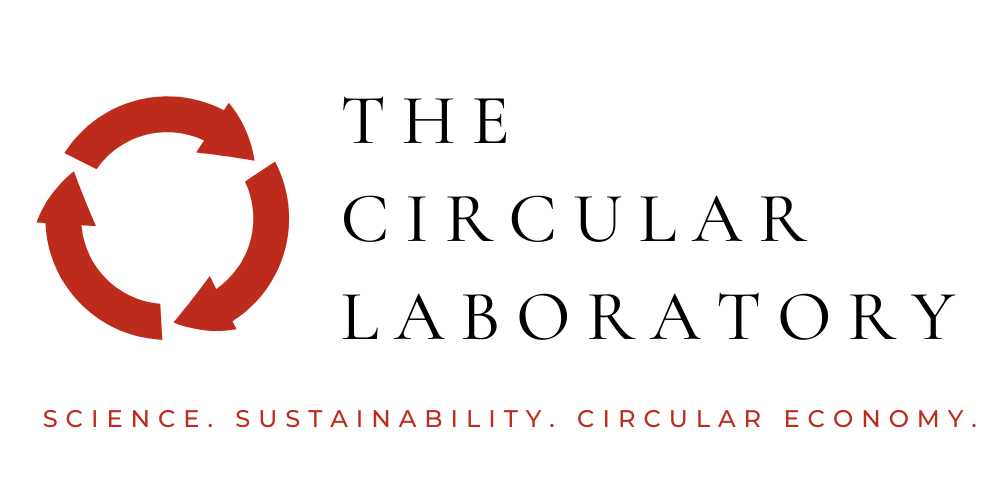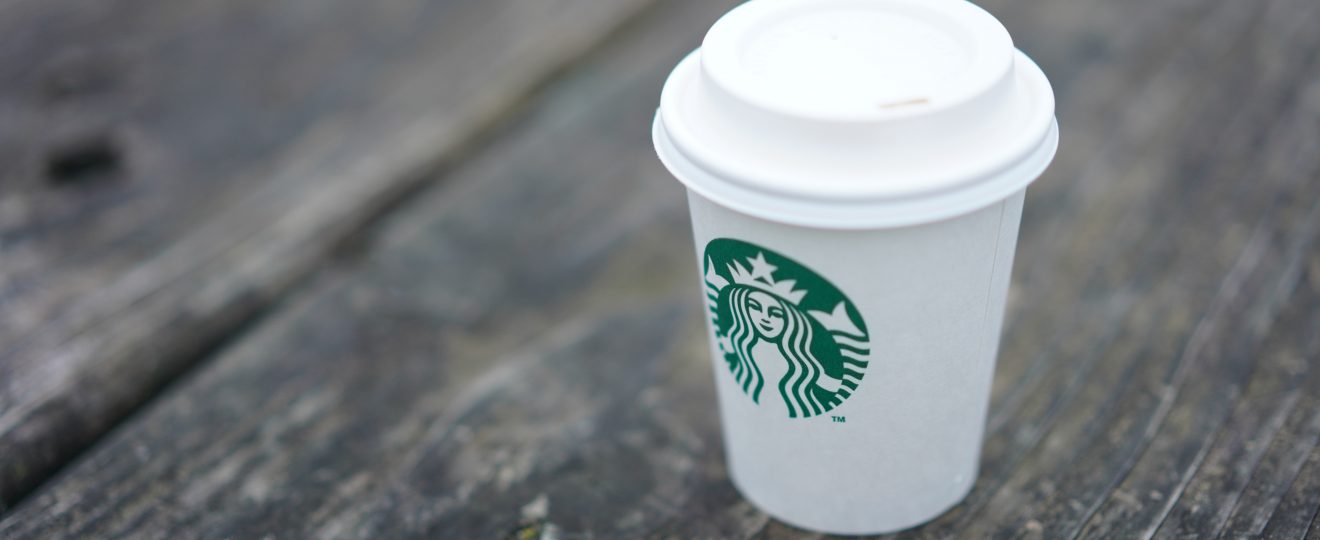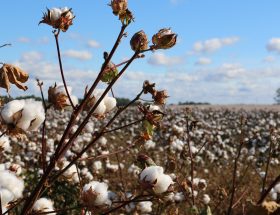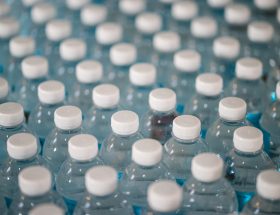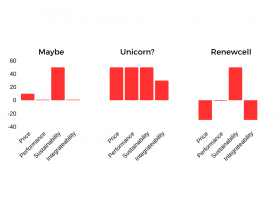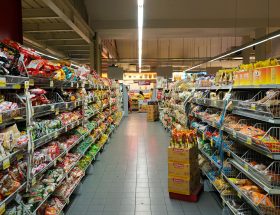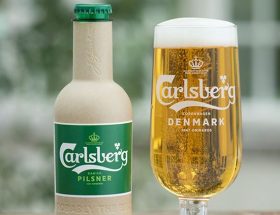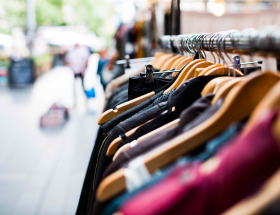By Dr. Ashley Holding
In March, coffee giant Starbucks announced the pilot of a range of compostable coffee cups in its stores in selected locations. But what are they made of, how are they different from other compostable coffee cups, and are they really sustainable?
The idea originated from the NextGen Cup Challenge – a competition launched in 2018 by a consortium including Starbucks, McDonalds, funding organisation Closed Loop Partners, and design-thinking leaders IDEO. The aim was to find a solution for single-use coffee cups. A number of solutions were selected as winners, including reusable cup solutions. One of the options selected was a paper cup coated with a compostable plastic lining called bioPBS (bio-based polybutylene succinate). It’s said to be both recyclable and home compostable. The initial locations for this pilot are Vancouver, Seattle, San Francisco, New York and London. A key test of the pilot in these cities will be to see if the cups prevent leaks, and keep the drinks hot.
There are also other options for compostable coffee cups, such as those offered by Vegware but they tend to be lined with a similar bio-based, but less compostable plastic PLA. They are used by a variety of smaller retailers, although have yet to see wide scale adoption. The key difference in the Starbucks pilot is that the new plastic bio-PBS is said to be “home compostable” that is, it can be composted in your home compost heap, in much milder conditions than an industrial composting facility.
Reusable Versus Single-Use Coffee Cups
Although reusable cups are also on the agenda, many coffee chains decided to suspend the use of reusable coffee cups during the coronavirus pandemic. This has left consumers with the only option to use single-use takeaway cups. A panel of experts has since discredited the notion that reusables are less safe, saying that if basic hygiene principles are observed, they shouldn’t be a risk to health. Although the rise of reusables is likely to continue, there may always be a market for at least some proportion of disposable coffee cups. In that case, is a fully compostable cup the way to go?
Why Are Current Single-Use Coffee Cups Not Sustainable?
Single-use cardboard coffee cups are lined with plastic. It’s quite easy to see why: without it, a paper coffee cup would become soggy very quickly and wouldn’t be incredibly useful for containing hot beverages.
However, this plastic lining causes complications when it comes to recycling of the product. The plastic lining will contaminate the product and make the paper unusable, it’s difficult to separate by hand, and requires special processes to separate in a recycling plant.
However, this means that they are not widely recycled – it’s more difficult than with paper, but it’s not impossible. There are in fact a few facilities which can recycle coffee cups, by separating the paper pulp and the plastic lining in a water flotation tank. After shredding the coffee cups, the plastic lining rises to the top, which can be separated, and the pulp sinks, which can be further processed into recycled paper and cardboard products. For example, the British paper company James Cropper has been recycling plastic-lined paper coffee cups since 2017 with its ‘Cupcycling’ process.
Why is recycling important? Paper in itself is an incredibly useful resource, but it is rather energy intensive to produce. Recycled paper and cardboard has a much lower carbon footprint. And since it is biodegradable, it will undesirably break down to produce greenhouses gases in a landfill. Ideally all new paper and cardboard produced should be recycled and kept in circulation for as long as possible, to provide the greatest environmental benefits.
Coffee cup recyclers, manufacturers and chains joined together to create the Paper Cup Recovery and Recycling Group (PCRRG). They claim that collectively, they have more than enough capacity (61,000 tonnes per year) to treat all of the UK’s coffee cup waste – the problem is mostly one of collection. More cups need to be collected and brought to places where they can be recycled. Currently only 1 in 25 coffee cups in the UK are actually recycled.
Many chains including Costa Coffee, Caffè Nero, McDonald’s and Starbucks have in-store collection points which will take cups for recycling at one of the handful of facilities. Starbucks also funded “The Cup Fund” with its increased 5p charge on single-use cups, which aims to expand the collection and recycling infrastructure for paper cups in currently underserved areas.
What Are Starbucks’ Compostable Coffee Cups Made From?
The coffee cups that Starbucks are trialling are paper lined with a plastic called bio-PBS™, or polybutylene succinate. It’s a bio-based and bio-degradable plastic that has particularly good properties for lining coffee cups. It has good heat resistance, bonds well to paper, is flexible, and can be processed on the same equipment used to make non-biodegradable plastic linings. It’s made by a Thai company called PTT MCC Biochem, which submitted the proposal for PBS-lined paper coffee cups for the NextGen Cup Challenge.
Although the word ‘bio’ is in the trademark name of this polymer, it’s only actually 50% biobased. This is because PBS consists of two different building blocks. Currently, one building block, succinic acid, is produced from corn and sugar feedstocks through a biochemical process, whilst the other, butanediol (BDO), comes from petroleum. However, it is in fact possible to create BDO from bio-based feedstocks too, as the Italian company Novamont is attempting to do. It’s too early to see whether industrial-scale production of BDO will be fully commercialised, but this shows that there is a potential path to making the PBS polymer fully bio-based.
Are Compostable Coffee Cups Sustainable?
From a plastic point of view, a coffee cup lined with PBS has the potential to have a lower carbon footprint than with a conventional petroleum plastic, such as polypropylene (PP). Although there are no good data sources that assess the life cycle of bioPBS specifically, a similar trend is seen with other bio-based plastics compared to petroleum-based plastics. It’s worth noting that both PP and PE plastics can also be made from bio-based feedstock such as sugar-cane and corn which make these options much more comparable. However, these are not biodegradable or compostable.
As regular The Circular Laboratory readers may know, there is a difference between something being biodegradable and it being compostable. In this case, there is good news: the lining is certified as home compostable by DIN CERTCO and other reputable certification bodies. This means that it should be suitable for composting in your home compost heap, as well as in larger industrial facilities. However, this always comes with the caveat that it will likely not degrade when littered in the natural environment.
Starbucks’ Compostable Coffee Cups And The Circular Economy
Just like with current single-use coffee cups, cups lined with PBS need to first be collected, and an infrastructure system needs to be in place to either recycle the cardboard and plastic component, or compost it. The convenience of single-use coffee cups is mostly for consumers in urban areas “on-the-go” and it can be expected that not all consumers have a home compost heap, or are not near one when they would typically be using a single-use coffee cup. So in reality, the most useful end-of-life pathways for coffee cups with compostable liners will be recycling or composting in industrial facilities. The ability to compost the cups in a home compost heap is an added bonus. The most important factor is still to ensure that the cups are actually collected for proper waste management.
However, is it better to compost the whole coffee cup, lining and all, or to separate the lining and cup and recycle the paper? From a circular economy standpoint, it is much more useful to recycle the paper in the cup. Keeping the paper fibres in circulation for a few more cycles, rather than destroying it in the composting process, would prevent production of new, resource intensive materials.
What about a possible hybrid ‘third’ option – to recycle the paper in the cup, but compost the lining that is separated from the cup?
The advantage, in this case, is that the separated lining can be composted where usually it would be burned for energy or landfilled. Very rarely is the separated plastic lining from the cup recycling process actually recycled. In the Cupcycling process the plastic is burned for energy and used to power the process. In theory, the new PBS polymer can actually be recycled. But given the market for this plastic is massively smaller than conventional plastics, there is not likely to be much demand for such a small amount of contaminated plastic film at present.
Incineration of the compostable lining would reclaim some energy, and in the case of many bio-based plastics, could lead to an essentially net-neutral carbon situation. The amount of carbon released includes its biogenic carbon content, carbon that has been sequestered from the atmosphere by plants. The advantage of incineration is that energy can be created which otherwise might be generated by the burning of fossils fuels.
Composting can also lead to a small amount of GHG emissions but will also return some carbon to a new cycle through the compost itself, even if carbon in the future goes on to exit a closed loop. In both of these cases, if the bio-based (biogenic) carbon content is 100%, the carbon emissions will be essentially neutral. Since PBS is only partially biobased, composting would lead to a release of some fossil carbon.
If there are no local composting or incineration facilities, landfilling of a compostable plastic is generally a worse idea than with conventional plastic, due to the release of the potent greenhouse gas methane when degradation happens under anaerobic conditions. So in that sense, introducing a compostable cup in a country with limited infrastructure would not be a good idea.
Is Composting of a Whole Coffee Cup Ever a Good Option?
The best applications for compostable plastics are typically where a steady supply of compostable material can be guaranteed, such as in food service and events management. Food waste, and compostable tableware and single-use items could all be collected as a single waste-stream, and directed to an appropriate composting facility. This was the conclusion of the EU in a recent report by consulting firm Eunomia. In this situation the case for composting is much more clear: composting cups along with coffee grounds, food waste and other compostable tableware could be a viable approach if the offtake of the waste is guaranteed by an industrial composter.
Will Starbucks’ Compostable Coffee Cup Gamble Pay Off?
The outcome of the Starbucks pilot remains to be seen, but what is clear is that its impact will be tied to the collection rate of the cups and how they they will be disposed of. Directing the compostable cups to recycling routes, rather than composting them whole with the liner will likely have a better overall environmental impact.
In terms of waste management, Starbucks’ compostable coffee cups offer another route of disposal for the lining of the cup after the paper is recycled. From a circular economy standpoint, the main priority should still be on recycling the paper content whilst incinerating or composting the lining.
The use of a bio-based plastic liner is likely to offer marginal decrease in the carbon footprint of the overall cup (since it’s only a very small part by weight). However, efforts can be made to increase the bio-based content of the polymer in the lining to 100% to increase the benefits even further. The main benefit will only be realised, however, in countries with relatively advanced infrastructure where incineration and composting are widespread.
Overall, the use of a compostable plastic liner in a coffee cup context is not likely have a negative impact on the wider system and may, in some situations, such as events, enable the collection of a stream of compostable material that may simplify waste collection when compared to non-compostable coffee cups. However, for any of this to have an effect, the collection of coffee cups at all points where the waste is generated needs to be stepped up significantly.
